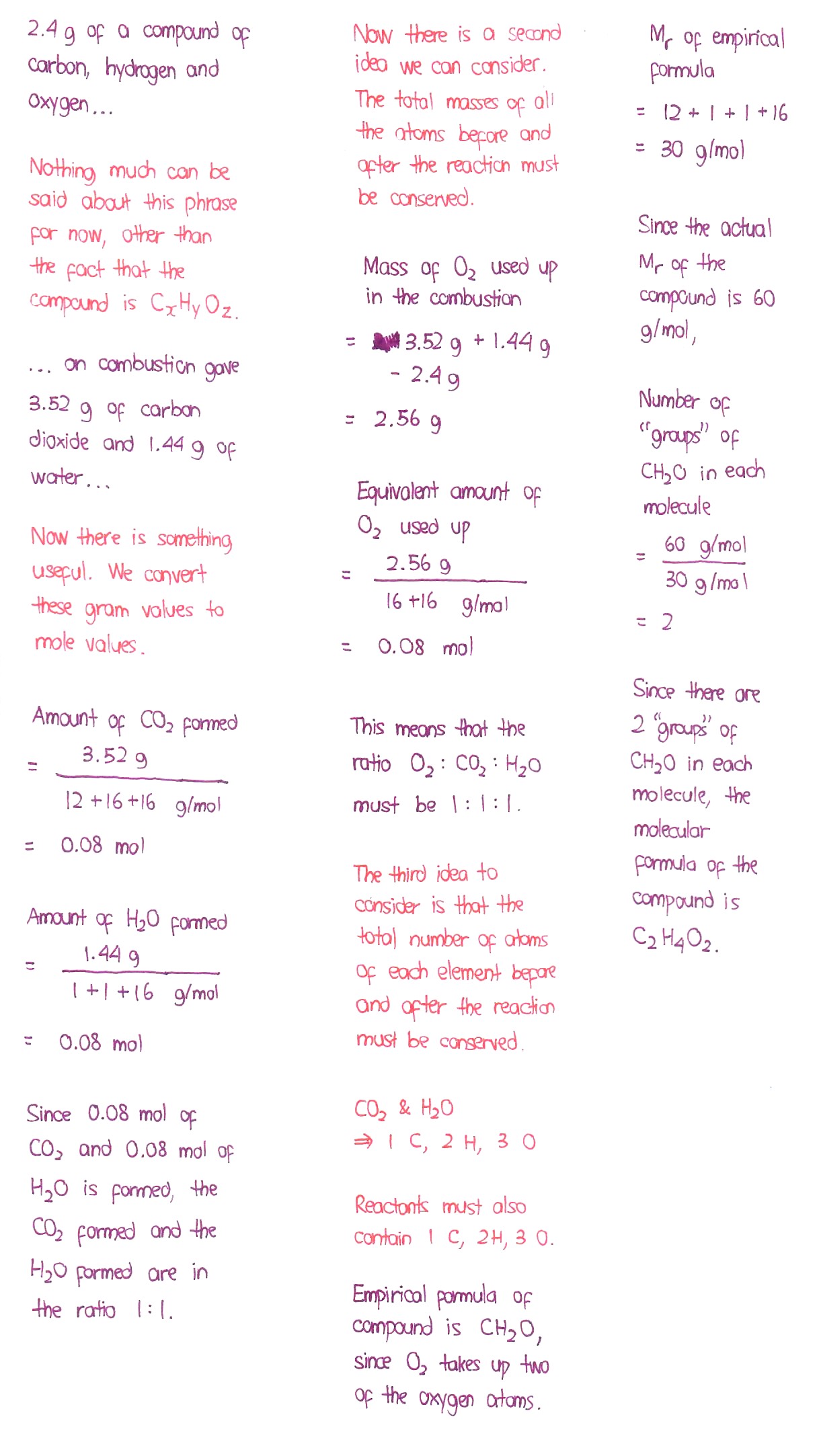Eric Nicholas K's answer to Sonia's Junior College 1 H2 Maths Singapore question.
done
{{ upvoteCount }} Upvotes
clear
{{ downvoteCount * -1 }} Downvotes
Good evening Sonia! Here are my workings for this question. Let me know if you need more explanation.
Date Posted:
4 years ago
Another way :
Firstly, know that the compound reacts with oxygen to form water(H2O) and carbon dioxide(CO2) only.
i)
all the carbon in the CO2 formed came from the compound.
So mass of carbon in compound
= mass of carbon in the CO2 formed
= 3.52g x Ar(C)/Mr(CO2)
= 3.52g x 12/44
= 0.96g
all the hydrogen in the H2O formed came from the compound.
So mass of hydrogen in compound
= mass of hydrogen in the H2O formed
= 1.44g x Mr(H2)/Mr(H2O)
= 1.44g x 2/18
= 0.16g
Mass of oxygen in compound
= Total mass of compound - mass of carbon inside - mass of oxygen inside
= 2.4g - 0.96g - 0.16g
= 1.28g
ii)
No. of mol of H in the compound
= 0.16g ÷ 1g/mol = 0.16 mol
No. of mol of O in the compound
= 1.28g ÷ 16g/mol = 0.08 mol
No. of mole of C in the compound
= 0.96g ÷ 12g/mol = 0.08 mol
Ratio of C : H : O
= 0.08 : 0.16 : 0.08
= 1 : 2 : 1
Empirical formula is CH2O.
Mr of CH2O = 12 + 2(1) + 16 = 30
Mr of compound = 60
60 ÷ 30 = 2
So there is twice the number of atoms in the molecular formula for each element.
Molecular formula = C2H4O2
(Side note : this product is likely to be acetic acid , CH3COOH)
Firstly, know that the compound reacts with oxygen to form water(H2O) and carbon dioxide(CO2) only.
i)
all the carbon in the CO2 formed came from the compound.
So mass of carbon in compound
= mass of carbon in the CO2 formed
= 3.52g x Ar(C)/Mr(CO2)
= 3.52g x 12/44
= 0.96g
all the hydrogen in the H2O formed came from the compound.
So mass of hydrogen in compound
= mass of hydrogen in the H2O formed
= 1.44g x Mr(H2)/Mr(H2O)
= 1.44g x 2/18
= 0.16g
Mass of oxygen in compound
= Total mass of compound - mass of carbon inside - mass of oxygen inside
= 2.4g - 0.96g - 0.16g
= 1.28g
ii)
No. of mol of H in the compound
= 0.16g ÷ 1g/mol = 0.16 mol
No. of mol of O in the compound
= 1.28g ÷ 16g/mol = 0.08 mol
No. of mole of C in the compound
= 0.96g ÷ 12g/mol = 0.08 mol
Ratio of C : H : O
= 0.08 : 0.16 : 0.08
= 1 : 2 : 1
Empirical formula is CH2O.
Mr of CH2O = 12 + 2(1) + 16 = 30
Mr of compound = 60
60 ÷ 30 = 2
So there is twice the number of atoms in the molecular formula for each element.
Molecular formula = C2H4O2
(Side note : this product is likely to be acetic acid , CH3COOH)
Alternatively,
Let the general formula of compound be CxHyOz since it only involves C,H and O.
Combustion involves oxygen.
Reaction equation is :
CxHyOz + (x + y/4 - z/2) O2 → xCO2 + (y/2) H2O
No. of mole of compound used
= 2.4g ÷ 60g/mol
= 0.04 mol
No. of mole of H2O formed = 1.44g ÷ 18g/mol = 0.08 mol
No. of mole of CO2 formed = 3.52g ÷ 44g/mol = 0.08 mol
Comparing the ratio of the no. of mol of compound and CO2,
nCO2 / nCompound = x/1 = 0.08/0.04 = 2
So x/1 = 2
x = 2
Comparing the ratio of the no. of mol of H2O and CO2,
nH2O/ nCO2 = (y/2)/x = 0.08/0.08 = 1
So (y/2)/x = 1
y/2x = 1
y = 2x = 2 × 2 = 4
Now CxHyOz ≡ zO
Comparing the ratio of the no. of mol of O in compound and no. of mol of compound,
nO / nCompound = 0.08/0.04 = 2 = z/1
z = 2
So the molecular formula is C2H4O2.
Empirical formula is CH2O.
So the equation is actually
C2H4O2 + 2O2 → 2CO2 + 2H2O
Let the general formula of compound be CxHyOz since it only involves C,H and O.
Combustion involves oxygen.
Reaction equation is :
CxHyOz + (x + y/4 - z/2) O2 → xCO2 + (y/2) H2O
No. of mole of compound used
= 2.4g ÷ 60g/mol
= 0.04 mol
No. of mole of H2O formed = 1.44g ÷ 18g/mol = 0.08 mol
No. of mole of CO2 formed = 3.52g ÷ 44g/mol = 0.08 mol
Comparing the ratio of the no. of mol of compound and CO2,
nCO2 / nCompound = x/1 = 0.08/0.04 = 2
So x/1 = 2
x = 2
Comparing the ratio of the no. of mol of H2O and CO2,
nH2O/ nCO2 = (y/2)/x = 0.08/0.08 = 1
So (y/2)/x = 1
y/2x = 1
y = 2x = 2 × 2 = 4
Now CxHyOz ≡ zO
Comparing the ratio of the no. of mol of O in compound and no. of mol of compound,
nO / nCompound = 0.08/0.04 = 2 = z/1
z = 2
So the molecular formula is C2H4O2.
Empirical formula is CH2O.
So the equation is actually
C2H4O2 + 2O2 → 2CO2 + 2H2O



